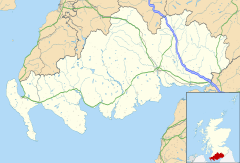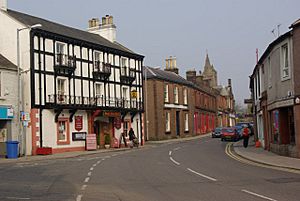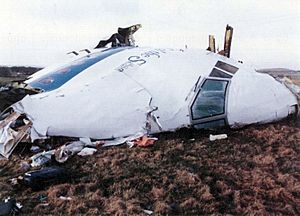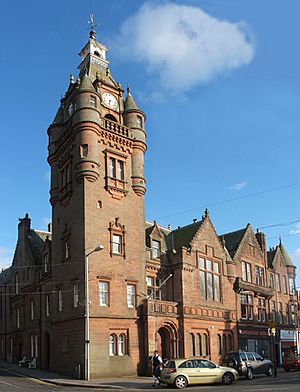Lockerbie facts for kids
Quick facts for kids Lockerbie
|
|
|---|---|
| Town | |
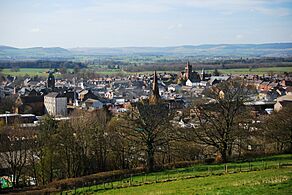 Skyline over Lockerbie |
|
| Population | 4,190 (2020) |
| OS grid reference | NY135815 |
| • Edinburgh | 58 mi (93 km) |
| • London | 283 mi (455 km) |
| Council area | |
| Lieutenancy area | |
| Country | Scotland |
| Sovereign state | United Kingdom |
| Post town | LOCKERBIE |
| Postcode district | DG11 |
| Dialling code | 01576 |
| Police | Dumfries and Galloway |
| Fire | Dumfries and Galloway |
| Ambulance | Scottish |
| EU Parliament | Scotland |
| UK Parliament |
|
| Scottish Parliament |
|
Lockerbie is a town in Dumfries and Galloway, located in south-western Scotland. It is about 120 kilometers (75 miles) from Glasgow. The town is also about 25 kilometers (15 miles) from the border with England. In 2001, about 4,009 people lived there. Lockerbie became known worldwide in December 1988 when a plane, Pan Am Flight 103, crashed there after an explosion on board.
Contents
Ancient Discoveries in Lockerbie
Life in the Stone Age
In 2006, archaeologists found amazing things in Lockerbie. They were digging before new schools were built. They discovered the remains of a very large timber hall. This hall was from the Neolithic period, also known as the New Stone Age. It was used between 3950 BC and 3700 BC.
The hall was about 27 meters (89 feet) long and 8 meters (26 feet) wide. People used it for a long time, even replacing some of the wooden posts. Inside, they found Flax seeds. This shows that people were growing and processing flax. Finding flax from this time is very rare in Scotland. Like many other Neolithic timber halls, this one was purposely burned down when it was no longer used. Another ancient site was found at Beckton Farm in Lockerbie. It was a place for making stone tools, rituals, and living.
Bronze Age Burials
During the school excavation, a Bronze Age cemetery was also found. This cemetery had both cremation (burning bodies) and inhumation (burying bodies). It was surrounded by what might have been a ring-cairn, a circular stone mound.
Archaeologists found a special pot called a Collared Urn. They also found a rare copper dagger. This dagger might have come all the way from Wales. Scientists used radiocarbon dating to find out the cemetery was used between 2140 BC and 1690 BC. Another Bronze Age cemetery was found at Kirkburn, Lockerbie, in the 1960s. Next to this cemetery, they found a kiln. This kiln was used for drying corn. It dates to the late medieval or early post-medieval period (1450–1800 CE).
Early Medieval Halls
An Anglian timber hall was also discovered during the school excavation. This hall dates to between 430 and 670 CE. It was built over an older structure. This older building looked like British structures from earlier times. This made archaeologists think that the Angles came into the area. They might have built their timber hall to show their power. It is thought that this hall could have been a meeting place. It might have been built during the time of Aethelfrith. This was when the Northumbrians first moved into south-west Scotland.
There is also a Roman camp called Torwood next to Lockerbie. All these discoveries show that people have lived in Lockerbie for at least 6,000 years.
Lockerbie's Past
Viking Roots and Early Growth
Lockerbie has been around since at least the time of the Vikings. This was around the year 900. The name "Lockerbie" comes from "Loc-hard's by." This means Lockard Town in Old Norse, the Viking language. Lockerbie first appeared in written records in the 1190s. This was in a document from Robert de Brus, 2nd Lord of Annandale. It gave the lands of Lockerbie to Adam de Carlyle. In 1306, it was called Lokardebi.
The Battle of Dryfe Sands
About 2 kilometers (1.2 miles) west of Lockerbie, a famous battle happened. On December 7, 1593, Clan Johnstone fought Clan Maxwell at the Battle of Dryfe Sands. The Johnstones won and caused many injuries to the Maxwells. Many Maxwells had sword cuts on their heads. This led to the saying "Lockerbie Lick."
Modern Town Development
Lockerbie started to grow a lot in 1730. The Johnstone family, who owned the land, made plots available. These plots were along the High Street. This helped create a planned settlement. By 1750, Lockerbie was an important town. From the 1780s, it became a stop for carriages. These carriages traveled between Glasgow and London.
The biggest growth for Lockerbie happened in the 1800s. Thomas Telford built the road from Carlisle to Glasgow through Lockerbie starting in 1816. The Caledonian Railway opened a train line in 1847. This line went from Carlisle to Beattock through Lockerbie. Later, it went all the way to Glasgow. From 1863 to 1966, Lockerbie was also a railway junction. It had a branch line that went to Dumfries. This line was called the Dumfries, Lochmaben and Lockerbie Railway. It stopped carrying passengers in 1952 and freight in 1966. Today, the town is served by Lockerbie railway station.
Lockerbie has been home to Scotland's largest lamb market since the 1700s. The arrival of the railway made its role in trading sheep even bigger. The railway also made coal cheaper. This allowed a gas works to be built in the town in 1855.
Hallmuir Prisoner of War Camp
About 1.5 kilometers (1 mile) south of Lockerbie are the remains of Hallmuir prisoner-of-war camp. After the Second World War, this camp housed Ukrainian soldiers. They were from the Galician Division. These soldiers built a chapel using old army huts. In 2003, this chapel became a Category B building. The chapel is still used today. Ukrainian services are held there on the first Sunday of every other month.
Pan Am Flight 103 Disaster
Lockerbie is known around the world because of an event on December 21, 1988. The wreckage of Pan Am Flight 103 crashed there after an explosion on board. In the United Kingdom, this event is often called the "Lockerbie disaster."
Eleven people living in the town were killed. This happened in Sherwood Crescent. The plane's wings and fuel tanks fell there in a fiery explosion. This destroyed several houses and left a large crater. Debris also damaged other buildings nearby. All 259 people on the flight also died. The 270 victims were from 20 different countries. This event remains the deadliest aviation disaster in Britain.
Lockerbie Academy, the town's high school, became the main center for help after the disaster. The academy worked with Syracuse University in the US. Syracuse University lost 35 students in the crash. They set up a scholarship at the university. Each year, two students from Lockerbie spend a year at Syracuse University. They are called Lockerbie Scholars. The head teacher of Lockerbie Academy, Graham Herbert, received an award in 2003. It was for his outstanding service.
A former student of the academy, Helen Jones, died in the London bombings on July 7, 2005. A new scholarship was created in her memory. It gives £1000 to accounting students from the academy.
Important Buildings and People
Much of Lockerbie is built from red sandstone. There are several impressive buildings near the town center. One of these is Lockerbie Town Hall, which was finished in 1880.
A little north of the center is the Dryfesdale Parish Church. It has a brightly decorated inside. The name Dryfesdale comes from the local river, the Dryfe Water. This river joins the River Annan west of the town.
The Dryfesdale Lodge Visitors' Centre opened on October 25, 2003. It used to be a cottage for cemetery workers. It was renovated with money from the Lockerbie Trust. The Lodge has two exhibition rooms. There is also the Dryfesdale Room for quiet reflection. One room has a permanent exhibition. It shows ten history panels about Lockerbie's past. These panels cover everything from its ancient origins to the 1988 plane crash and beyond. In the cemetery grounds nearby is the Lockerbie Memorial Garden of Remembrance.
Lockerbie House and Famous Residents
Lockerbie House was built in 1814. It was for Sir William Douglas, 4th Baronet of Kelhead and his family. Many members of the Douglas family lived there over the years. This included John Sholto Douglas, who became the 9th Marquess of Queensberry. He loved sports, especially boxing. In 1866, he helped start the Amateur Athletic Club. This club later became the Amateur Athletic Association of England. The next year, the club published twelve rules for boxing matches. These rules were written by John Graham Chambers. But they became famous under Queensberry's name and are known as the "Marquess of Queensberry rules."
Lockerbie House is a very important place in Lockerbie. In the past, it was owned by the Johnstone Baronets and Douglas family. They also owned most of the land and houses in the town. Like many buildings in Lockerbie, this Georgian house is built of old red sandstone. It has about 40 bedrooms. It is located on 78 acres (31 hectares) of private woodland and gardens. There are also other buildings, like a gatehouse and a walled garden.
This large property has often been used as a country house hotel. Now, an outdoor pursuits company called Manor Adventure owns the house. It is used as a center for school activity courses and family adventure holidays.
Steven's Croft power station opened in 2008. It is just north of the town. This power station is the largest biomass-powered electricity generator in the UK.
Sports and Recreation
Lockerbie Ice Rink was built in 1966. It is across the road from Lockerbie Academy. It is one of the oldest indoor ice rinks in the United Kingdom.
The town's main football club is Mid-Annandale. They play in the South of Scotland Football League. The club plays at King Edward Park, which has been recently updated.
See also
 In Spanish: Lockerbie para niños
In Spanish: Lockerbie para niños


